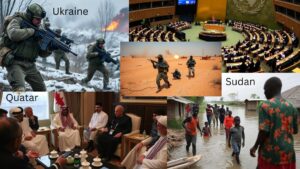The conflict between Israel and Hamas has reached a critical juncture, with Israeli Defense Minister Israel Katz warning that “the gates of hell will open” if Hamas fails to release the remaining 59 hostages held in Gaza. This stark ultimatum follows weeks of stalled negotiations over extending a fragile ceasefire initially brokered in January 2025. As tensions escalate, the humanitarian situation in Gaza continues to deteriorate, with thousands facing starvation and medical shortages. Here’s a breakdown of the crisis and its implications
Timeline to Crisis
- Jan 19, 2025: Ceasefire begins; 30 hostages freed.
- Feb 10: Hamas halts releases, accuses Israel of blocking aid.
- Feb 15: Trump’s first deadline passes; no deal.
- March 3: Israel warns of imminent invasion: “Gates of hell will open.”
Civilians Caught in the Crossfire
Over 48,000 Gazans have died since the war began in October 2023, with thousands more injured or trapped under rubble. The current aid blockade has left 2.3 million residents facing “unbearable levels of deprivation,” per UN Secretary-General António Guterres. Hospitals report critical shortages of anesthesia and antibiotics, while families ration dwindling food supplies.
Hamas’s use of civilian infrastructure for military operations has drawn scrutiny, but Israel’s restrictions on aid convoys have intensified suffering. Egypt and Jordan have rejected Trump’s proposals to relocate Gazans, calling instead for reconstruction plans that preserve Palestinian sovereignty.
Psychological Warfare and Hostage Conditions
The emaciated state of three hostages released in February—Eli Sharabi, Ohad Ben Ami, and Or Levy—highlight Hamas’s brutal treatment of captives. Trump described their condition as “shocking,” citing visible signs of malnutrition and psychological trauma. Hamas’s armed wing, the Al-Qassam Brigades, has weaponized hostage releases, staging public humiliations to demoralize Israeli society.
Israel’s Military Posturing
Netanyahu has ordered the IDF to “amass forces inside and surrounding Gaza”—a move interpreted as preparation for a ground invasion targeting Hamas’s tunnel networks. Defense Minister Katz hinted at “methods Hamas has not known,” likely referencing cyber warfare, AI-driven drone strikes, or collaborations with U.S. intelligence agencies.
Hamas’s Calculated Defiance
Hamas’s refusal to capitulate stems from its alliance with Iran, which provides funding, training, and strategic guidance. The group’s February 8 meeting with Ayatollah Khamenei in Tehran underscores this partnership. By prolonging negotiations, Hamas aims to extract concessions such as prisoner releases and international recognition.
Trump’s Gaza Ambitions
Trump’s vision to “buy and own Gaza” has alarmed Arab leaders. His plan envisions U.S.-funded infrastructure projects managed by Middle Eastern allies, effectively erasing Palestinian claims to the territory. Critics argue this approach mirrors colonial-era land grabs and risks radicalizing populations across the region.
Egyptian and Qatari Diplomacy
Egypt has proposed a “comprehensive vision” for Gaza’s reconstruction that avoids mass displacement, focusing instead on rebuilding hospitals, schools, and utilities. Qatar, a key Hamas financier, is mediating talks to resume hostage exchanges, though progress remains elusive.
The U.S. Dilemma
Trump’s combative rhetoric contrasts with State Department appeals for restraint. While the White House supports Israel’s right to self-defense, officials privately worry that a Gaza invasion could destabilize Jordan and Lebanon, where Hezbollah has threatened retaliation.
The Stakes of a New War
Immediate Risks
- Full-Scale Invasion: An IDF offensive could kill thousands and displace hundreds of thousands of Gazans.
- Regional Spillover: Hezbollah or Iranian proxies might open new fronts in Lebanon or Syria.
- Political Fallout: Netanyahu’s government could collapse if hostages perish, while Trump’s Gaza plan faces bipartisan opposition.
Long-Term Implications
A prolonged conflict risks entrenching Hamas’s narrative of resistance, undermining moderate Palestinian factions. Conversely, a decisive Israeli victory could empower Netanyahu to annex parts of Gaza, reshaping the region’s geopolitical map.
Beyond the Brink: A Call to Action
As the clock ticks down, international leaders must intervene to prevent a humanitarian catastrophe. The path forward involves a balanced approach: ensuring the safe release of hostages while addressing Gaza’s dire humanitarian needs. The world watches anxiously, hoping diplomacy will prevail over the specter of war.
Key Takeaways
- 59 hostages remain in Gaza—24 confirmed alive, 35 dead.
- U.S. pressure intensifies: Trump backs Israel’s threat, demanding action by March 8.
- Humanitarian collapse: 2.3 million Gazans face starvation as aid stalls.
- Trump’s “Gaza real estate” plan sparks outrage in Arab nations.
FAQs
Q. How many Americans are hostages?
A. At least 8 dual U.S.-Israeli citizens, per State Dept.
Q. What’s Hamas demanding?
- Israeli troop withdrawal from N. Gaza
- Return of displaced Palestinians
- 500 Palestinian prisoners released
Q. Could Trump really “buy Gaza”?
A. Unlikely—but his $2B “infrastructure plan” aims to bypass Palestinian governance.







